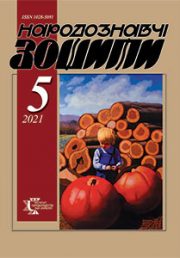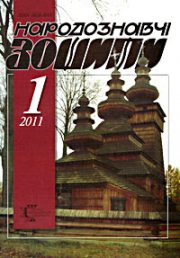The Ethnology Notebooks. 2022. № 1 (163), 57—64
UDK 069:008(=161.2:438)-051Л.Гец
DOI https://doi.org/10.15407/nz2022.01.057
LION GETZ’ — MUSEUM WORKER: LITTLE-KNOWN PAGES OF THE MUSEUM «LEMKIVSHCHYNA» IN SANOK 1930—1939
GAKH Iryna
- ORCID ID: http://orcid.org/0000-0002-5627-7039
- Ph. D in Art History,
- Head of Postgraduate and Doctoral Studies,
- Lviv National Academy of Arts,
- 38, Kubiyovycha Street, Lviv, Ukraine,
- Contacts: e-mail: gachiruna@gmail.com
Abstract. Lion Getz is a well-known Ukrainian artist who was forced to live and work in Poland for most of his life. In the Soviet period, the artist’s name was not mentioned at all, and his creative achievements became part of Polish art culture. The artist’s works are in galleries and private collections in Ukraine, Poland, Italy, Canada and America. Revealing the life and creative work of Getz in art publications, we tell about the processes of formation of European culture of the first half. of XX century.
A special place in the history of Ukrainian art and museology is occupied by the interwar period, when the artist lived and worked in Sanok.
Research aim — complex clarification of not popular facts of professional activity of Lion Getz’, becoming and functioning of museum of «Lemkivshchyna»: participating of artist in creation and development of only culturological lemko establishment on territory of Poland. A research object is a role of L. Getz’ in the development of museum of «Lemkivshchyna» 1931—1939. The article of represents history of museum of «Lemkivshchyna» and labour of Lion Getz’ by a director, researcher, restorer of only museum of lemko culture on the territory of Poland. The territorial and chronologic limits of research are outlined by east Lemkivshchyna, (presently Sanok district of the Subcarpathian Province of Poland) by a period of 1930—40.
A research basis is made by the archives of the Institute of National Memory (Poland) 1950—70th and Archive of Lion Getz’, that is kept to the Historical museum.
A scientific novelty consists of presented documentarily-historical materials of life and work of Lion Getz, that kept in the archives of Institute of National Memory in Poland (IPN) and Archives of historical museum of Sanok (Akta Museum «Lemkivshchyna» of Sanok of 1931—39) in relation to creation and functioning of museum of «Lemkivshchyna» in Sanok 1931—1944.
The study presents a multifaceted and unknown material that has not been covered in art history literature for a long time.Only thanks to the work of the author in the mentioned institutions, we have the opportunity to consider the work of the artist in the museum field.
Research methodology consists in application of history-cultural approach at contextualization of the marked circle of the artistic phenomena. For consideration of historical art critic of art range of problems formally-analytical and structural-typological methods are used.
Keywords: Lemkivshchyna, a museum, research labour, fund collection, old sights, conventions of museum workers, scientific.
Received 31.01.2022
REFERENCES
- Gornyatkevich, D. (1962, 30.01). Lev Getz. Svoboda [in Ukrainian].
- Gakh, I. (2017). The era of the Metropolitan — Ukrainian fine arts of the first half of the twentieth century. Lviv: Manuscript [in Ukrainian].
- Akta Museum «Lemkiwszczyna» in Sanok from 1931—1939. Library, 100 [in Polish].
- Institute of National Remembrance (IPN), 010 / 10948/4 [in Polish].
- Kotowicz, P., & Orlowska-Synus, A. (2012). Pottery from pre-war research on an early medieval stronghold in stupnica from the collection of the historical museum in Sanok. Fortress: збірник заповідника «Тustan’», 2. Lviv: Kolir PRO [in Polish].
- Sydor, O. (2006). Lemkivshchyna Museum in Sanok. Ukrainian heritage [in Ukrainian].
- Archive of the Historical Museum in Sanok. Memoirs of Goetz L., manuscript b. n. [in Polish].
- Gornyatkevich, D. (1962, 30.01). Lev Getz. Svoboda
- Dobrianska, I. (1963, may 26). Solomiya Krushelnytska in the Lemkiv region. Nashe Slovo. Warsaw [in Ukrainian].
- Getz, L. (1957, march 3). History of the Lemkivshchyna Museum in Sanok. Nashe Slovo, 13 [in Ukrainian].







